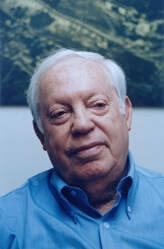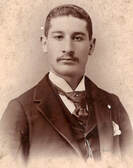JEWISH CEMETERY
Przerośl Sign
English version of the Information signboard dedicated on August 9, 2023:
The Przerośl Jewish Community
Although there were Jews in Przerośl since the founding of the town in the 16th century, the Jewish population increased starting in the 18th century. In 1728 there were four Jewish innkeepers. In 1736, the Bishop of Vilnius, Bishop M. Sienkiewicz, allowed the Jewish community to build a synagogue and to lay out a cemetery on Zusenkowskiej Street.
There were burials in the cemetery until 1939, so there would have been several thousand gravestones (Hebrew ‘matzevot’). Today there are around 30 matzevot, most of which were returned to the cemetery by Przerośl townsman, Wiesław Podziewscy, in the late 1990s. One of the most beautiful aspects of the cemetery is the early 19th century stone wall, with its abstract carved design. The cemetery was cleared and cleaned in 2017-2020 by Jewish descendants from the U.S., Israel, France, and South Africa, with assistance from local townspeople.


In 1784 there were 50 Jews in Przerośl. In 1799, there were 205. In 20 years’ time, there were already 443. And in 1867, they formed a large community of 598 people. The 1864 tax list of Jewish households has 129 households, with 61 unique surnames. The surnames include families that lived in Przerośl already in the 1784 Grand Duchy of Lithuania Poll Tax record, e.g., the Kalwarjyski family which later took the surname Margolis. Other large families with 4 or more households in 1864 were Abramski, Abramajtys, Motulski, Myszkowski, Raczkowski, Wierzbołowski, and Winnicki.

Many of these families lived in Przerośl until the Holocaust. The Yad VaShem Shoah Database has 157 records for Przerośl, which includes the following surnames, also found in the 1864 tax list: Abramajtys, Abramski, Białostocki, Chodnik, Łanowicki, Maryampolski, Motulski, Myszkowski, Peltyn, Raczkowski, Rakowski, Szewczynski, Wierbołowski, Winnicki and Zejman.
Jews mostly lived close to the city market (the rynek) and were middle class in wealth. They were mostly craftsmen and tradesmen (e.g., clockmaker Echryzel Zukowski and glazier Gotlib Ilinc). Jews owned six breweries, nine distilleries, and 16 inns. The 1820 census mentions 10 innkeepers as among the city's most wealthy people. The wealthiest was Nysko Abramski. During the period between the two world wars, Jews were tradesmen. The former wooden church in Przerośl was built by Jewish carpenter Abraham Peltyn.

The main source of income for local Jews in the late 19th and into the 20th century was trade, crafts, and smuggling goods across the nearby Prussian border. Jews were also owners of breweries, vodka distilleries and inns. Up until December 1939, when they were deported by the Germans, Jews comprised 25% of the town’s population and in the mid-19th century as much as 36%.
Even into the 20th century, the houses on the market square were owned by Jewish families, one exception being the Sienkiewicz family who lived on the market square with their Jewish neighbors since the 1700s.
At the end of the 19th century and during the period between the wars, many Jews emigrated to the United States, with a few people emigrating from nearly every family. The Bramson and Margolis families settled in Ohio, the Frankel family in Peoria, Illinois.

After September 24, 1939, when Russians occupied Przerośl, Jewish homes and shops were robbed by Russians. The last rabbi was Rabbi Kowalski.
September 28, 1939, brought a change of government, as the Germans took the city from the Russians. In December of 1939, the Jews of Przerośl were deported by the Germans to camps in Siedlce and Łuków, where most of them died. The rest of the Jews were transferred to Treblinka and were killed there.
Only one person survived after leaving Łuków with his parents and aunt and uncle and fleeing to the east; Mordechai Abramski fought with the Polish underground, and later with the Jewish Brigade of the British Army, and eventually made it to Palestine where his older brothers, Shmuel, and Yosef, had settled.

Yosef Abramski became Yosef (Joseph) Aviram, a well-known Israeli archaeologist, a native of Przerośl, who passed away in Jerusalem, Israel at the age of 107 in 2022. “Born in Poland in 1915, Joseph (or Yosef as he liked to be called) immigrated to Mandatory Palestine in 1936.
A few years later, in 1940, he became the secretary of the Israel Exploration Society, the IES, then known as the Jewish Palestine Exploration Society, an organization dedicated to supporting archaeological work in the land of Israel and disseminating knowledge of archaeological finds to the broader public. He was appointed IES Director in 1983 and then served as the organization’s President from 2009 until his death… and was a key figure in the development and popularization of the field of biblical archaeology.” See citation.
Rabbi Ben Frankel and his brother, M.J. Frankel, were sons of Julius (Lejb) Frankel of Przerośl, shown as a young man in Przerośl at left.
Julius Frankel was the brother of Harry Frankel (above) and of Joseph Aviram’s grandmother, Rocha Leah Frankel, of Przerośl. And in this generation, another descendant of the Frankels, Julius Frankel’s great granddaughter, Stephanie Szostak, joins the ranks of famous descendants of natives of the Przerośl Jewish Community.
Stephanie Szostak left her native France to study business, as well as playing varsity golf at the College of William & Mary. At twenty-nine years old, after a brief stint in the corporate world in New York City, she took a leap and dove into the acting world. Her most notable projects include the ABC hit series A Million Little Things, Iron Man 3, and The Devil Wears Prada. She is a mental advocate, a Give an Hour Ambassador, and author of the workbook Self!sh. She lives in Connecticut with her husband and two sons. |
 |
We extend gratitude to the many descendants of Przerośl Jewish families who supported us, including descendants of the Abramski, Abramajtis, Bramson, Frankel, Margolis, Motulski, Myszkowski, and Wartelski families. Thanks also to Friends of Jewish Heritage in Poland, FODŻ, and The Matzevah Foundation, especially Dr. Steven Reece and Kevin Little. We appreciate the friendship and help of our local supporters: the Liszewski family, especially Agata Liszewska, Rafał Bukowski, Kazimiersz Leończuk, Wiesław Podziewscy, Mayor Marcin Brzozowski, the late folklorist Jarosław Rynkiewicz, and our long-time special supporter prof. Jan Wiktor Sienkiewicz.
Read more about the FJHP Przerośl cemetery project by clicking here.
GALLERY
Questions about the Przerośl cemetery project? Please send us a message:









